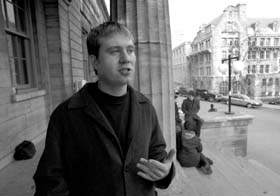
| ||
 | ||
 PhD student Dean Irvine PHOTO: OWEN EGAN |
"Accidental" book draws raves
|
BRONWYN CHESTER | When Dean Irvine set off last year, Winnipeg-bound, for two weeks in the University of Manitoba's archives, he had no idea that he was about to take a detour from his thesis. The 26-year-old doctoral student in the Department of English couldn't foresee that he would be a published editor one year later either, his book highly praised in The Globe and Mail to boot.
The fateful trip to Manitoba, made possible by a $1,000 Margaret Gillett graduate research grant from the McGill Centre for Research and Teaching on Women, was embarked upon in order to examine the correspondence and unpublished poems of Dorothy Livesay from the '30s and '40s. The late poet (1909Ð1996) is but one of numerous female Canadian poets and editors of literary magazines of the period 1932-1956 whom Irvine is researching for his dissertation. But when Irvine discovered the quantity and quality of unpublished or uncollected poems in the archive, he was overwhelmed. "There was a mass of material to draw upon," says Irvine. He mentioned the find to a friend who happened to be a book publicist. The friend asked if there were enough poems for a book. When Irvine replied in the affirmative, the publicist set to work on Arsenal Pulp Press, a small publishing house in Victoria, Irvine's hometown. The press gave the go-ahead, sight unseen -- "They didn't even ask for my CV!" -- and the young editor was off on a marathon of reading, transcribing and selecting the final 180 poems in the 282-page volume. Irvine's odyssey took him to Winnipeg, where he returned for four weeks, to Kingston, where Queen's University has a complete set of copies of original Livesay papers kept at the University of Calgary, and to the University of Toronto, which has more of Livesay's correspondence. Living off student loans, Irvine felt he couldn't spend too much time away from home on the Livesay project. In fact, as he explains over a coffee, the time factor meant that he hardly took a break during the various archives' entire opening hours -- and beyond. At the university library archives in both Winnipeg and Kingston, Irvine was amazed at the kindness librarians and staff showed him; one bringing him his lunch and finding reasons to stay late to let the researcher remain longer, another bringing him a needed book from a distant library. (U of T, on the other hand, was an entirely different kettle of fish, moans Irvine.) Fittingly, the fruit of Irvine's labours is titled Archive for Our Times, words taken from a poem by Livesay, "Anything Goes" (1983): Above all / a poem records / speech: / the way it was said / between people animals birds / a poem is an archive for our times. While Irvine immersed himself in Livesay's archive, he found that the poet herself had a very particular -- and very conscious -- relationship to her own archive, which began with her first published poems in the '20s. As he writes in the book's postscript: "Beginning in the late fifties, Livesay would repeatedly turn to her archive of unused poems as a source for her retrospective collections." And they were numerous: seven of her 21 collections were retrospectives, notes Irvine. "Archive for Our Times merely extends Livesay's own practice of selective recovery from her unpublished and uncollected oeuvre." Only this time the selection, which required reducing 1,200 typed pages to 300, was made not only for quality, but also for what the poems reveal about the development of the poet. That is a task that Irvine undertook with extraordinary care, if the detail in the book's postscript is any indication. The paper sleuth figured out which version of which poem was revised for which periodical, using such clues as typeface. He deduced, for instance, that a 1930s poem he found was, in fact, revised in the '60s. The give-away: the IBM Selectric typewriter font. Was all this a labour of love for Livesay's poetry? Yes, Livesay was a poet and human being for whom Irvine has "incredible respect." One of his favourite poems of hers is her most famous, "Green Rain," written in the '20s. And of those he uncovered, "The Hammer and the Shield," which documents the life and work of Dag Hammarskjold, former secretary general of the United Nations, "was the most amazing find." Irvine also has a profound affection for archives tied to the pleasure of discovering the workings of an artist. "You get to see the process, know the handwriting, sense the pace, the haste. There are just so many non-academic indicators of a life having been lived," says Irvine. He adds that writers' archives "document the development of our national literature." What prompted Livesay -- someone who changed fields and friends every two years or so, working variously as a journalist, teacher, social worker, editor, scriptwriter and political activist -- to keep going back to her earlier poems? Irvine wonders aloud, then answers: "She led a revised life. She never reached a stable point. She was always seeking the next place." And Irvine? Now that he has completed the book's six-city reading tour -- which included such luminaries of Canadian poetry as Di Brandt and Miriam Waddington, both of whom contributed to the book, and Bill Bissett and Lorna Crozier -- what's his next mission? Facing his laptop to finish the thesis begun before Dorothy Livesay interrupted his life.
|
|
| |||||